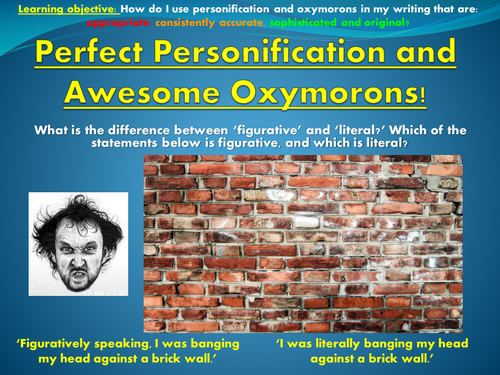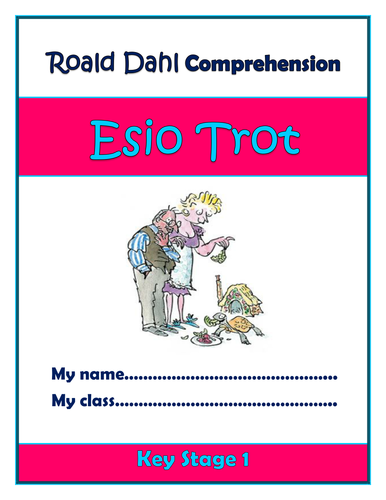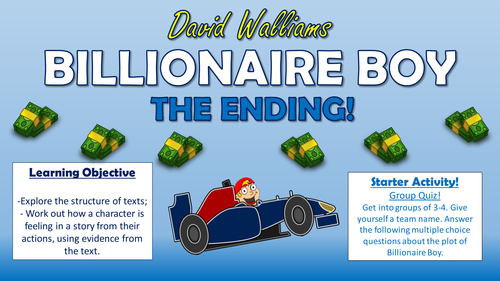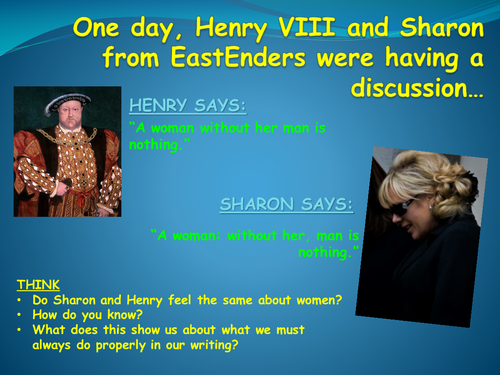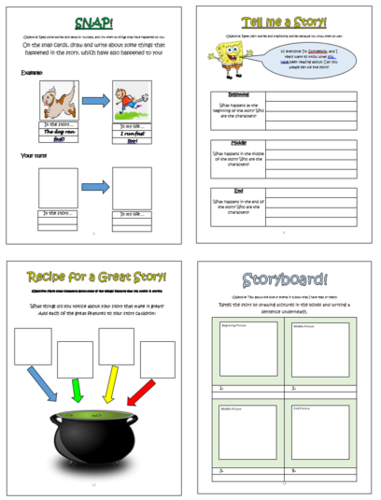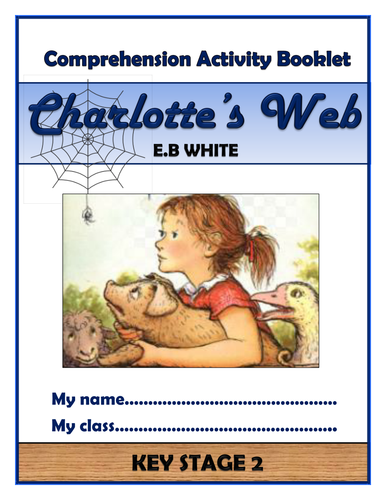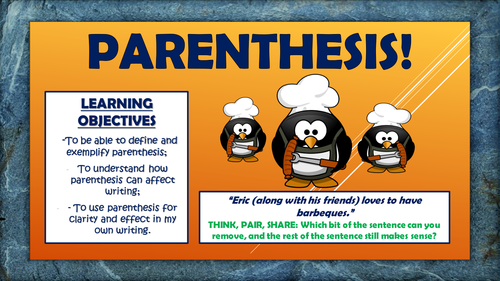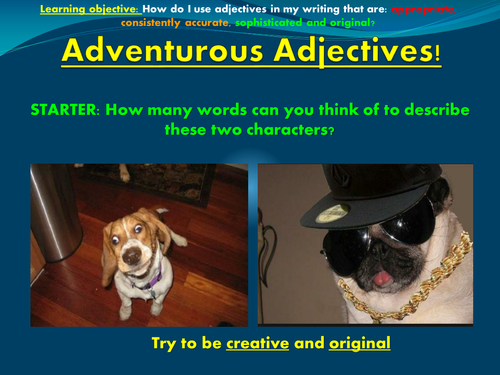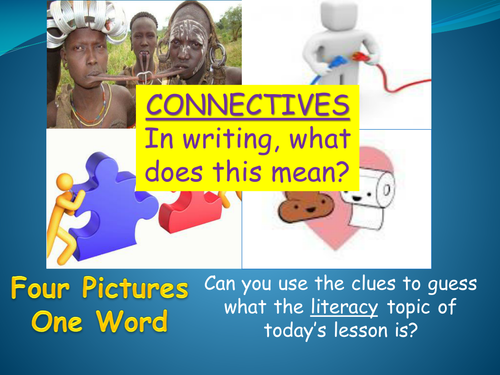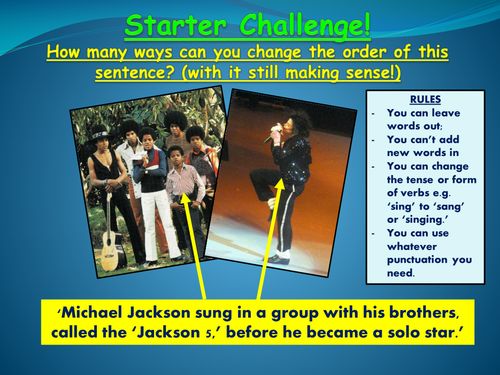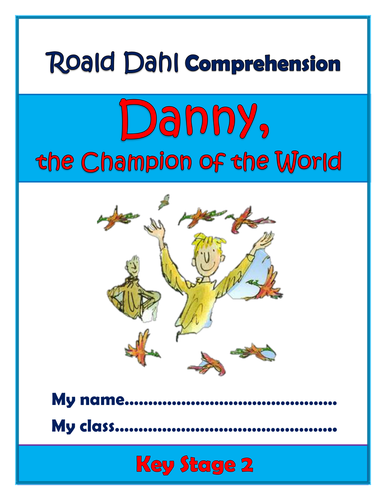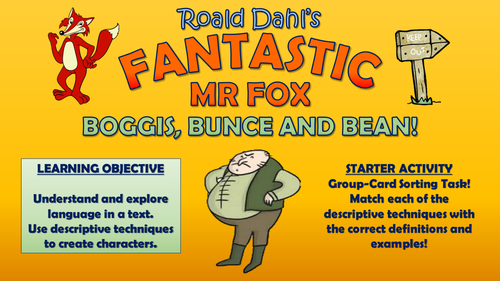
3k+Uploads
1903k+Views
2236k+Downloads
Literacy for early childhood

Perfect Personification and Awesome Oxymorons!
This is an exciting and engaging lesson/set of tasks aiming to build students' skills at using personification and oxymorons in their writing . It was taught during an observation lesson where the teacher received an Outstanding judgement.
Students learn to:
- Define and give examples of what personification and oxymorons are;
- Identify personification and oxymorons in fun and interesting examples;
- Analyse what makes them effective;
- Create their own personification and oxymorons using step-by-step advice;
- Peer assess using a clear and succinct success criteria.
It comes complete with:
- Engaging and visual PowerPoint to guide students (and teacher!) through the lesson;
- Colourful and thought-provoking two-part worksheet for the two main create tasks;
- Lesson plan/ teacher guidance sheet, which goes through the lesson step-by-step;
All pictures are licensed for commercial use, and image authors cited on the final slide.
This lesson can also be bought as part of the Descriptive Devices bundle for just £5. The bundle leads students through each language device needed in order to write to describe confidently.
Alternatively, you can buy the Descriptive Writing Big Bundle (All descriptive devices lessons, structuring and organising writing lesson, capturing the readers attention lesson, and the literacy writing mat) for £6.

Billionaire Boy - KS2 Comprehension Activities Booklet!
This resource booklet contains a wide range of age-appropriate, engaging, and meaningful comprehension activities for use throughout the reading of David Walliams' 'Billionaire Boy.' Teachers have found them particularly useful in comprehension or guided reading sessions. They are perfect for aiding the progress of children towards meeting the upper KS2 expectations within the new National Curriculum framework. Children love learning from these resources, whilst they are also of great use to teachers, as there is explicit information within each task regarding which comprehension strands the task is designed to demonstrate. They also relate to key extracts, characters, and themes from the story, ensuring that children gain a deep understanding of the text.
Activities within the booklet include:
- 'An Interview with Joe Spud' - to enable students to demonstrate that they can: 'Understand what is read by drawing on information from more than one paragraph, identifying key details that support the main ideas, and using quotations for illustration;'
- 'Walliams' Description' - to enable students to demonstrate that they can: 'Explain meanings of words that they know and ask the meaning of new words. Link the meaning of new words to words that they already know;'
- 'The Grubbs!' - to enable students to demonstrate that they can: 'Understand what is read by drawing on information from more than one paragraph, identifying key details that support the main ideas, and using quotations for illustration;'
- 'Figurative Language in Billionaire Boy' - to enable students to demonstrate that they can: 'Discuss and evaluate how authors use language, including figurative language, to create an impact on the reader.'
Plus many, many more activities (the booklet is 21 pages in length!) I've also added it as a PDF in case the formatting differs on your computer.
All images are licensed for commercial use, and are cited on a separate document (included).

Skellig - KS2 Comprehension Activities Booklet!
This resource booklet contains a wide range of age-appropriate, engaging, and meaningful comprehension activities for use throughout the reading of David Almond's 'Skellig.' Teachers have found them particularly useful in comprehension or guided reading sessions. They are perfect for aiding the progress of children towards meeting the upper KS2 expectations within the new National Curriculum framework. Children love learning from these resources, whilst they are also of great use to teachers, as there is explicit information within each task regarding which comprehension strands the task is designed to demonstrate. They also relate to key extracts, characters, and themes from the story, ensuring that children gain a deep understanding of the text.
Activities within the booklet include:
- 'An Interview with Michael' - to enable students to demonstrate that they can: 'Understand what is read by drawing on information from more than one paragraph, identifying key details that support the main ideas, and using quotations for illustration;'
- 'Almond's Description' - to enable students to demonstrate that they can: 'Explain meanings of words that they know and ask the meaning of new words. Link the meaning of new words to words that they already know;'
- 'Mina!' - to enable students to demonstrate that they can: 'Understand what is read by drawing on information from more than one paragraph, identifying key details that support the main ideas, and using quotations for illustration;'
- 'Figurative Language in Skellig' - to enable students to demonstrate that they can: 'Discuss and evaluate how authors use language, including figurative language, to create an impact on the reader.'
Plus many, many more activities (the booklet is 21 pages in length!) I've also added it as a PDF in case the formatting differs on your computer.
All images are licensed for commercial use, and are cited on a separate document (included).

Esio Trot - Roald Dahl - KS1 Comprehension Activities Booklet!
This resource booklet contains a wide range of age-appropriate, engaging, and meaningful comprehension activities for use throughout the reading of Roald Dahl's 'Esio Trot.' (Teachers have found them particularly useful in comprehension or guided reading sessions). They are perfect for aiding the progress of children towards meeting the KS1 expectations within the new National Curriculum framework. Children love learning from these resources, whilst they are also of great use to teachers, as there is explicit information within each task regarding which comprehension strands the task is designed to demonstrate. They also relate to key extracts, characters, and themes from the story, ensuring that children gain a deep understanding of the text.
Activities within the booklet include:
- 'Feed Alfie' - to enable students to demonstrate that they can: 'talk about their favourite words and phrases in the story;'
- 'Dahl's Description' - to enable students to demonstrate that they can: 'Explain meanings of words that they know and ask the meaning of new words. Link the meaning of new words to words that they already know;'
- 'Mr Hoppy's Plan' - to enable students to demonstrate that they can: 'Say what might happen next in a story based on what has happened so far;'
- 'Story Mountain' - to enable students to demonstrate that they can: 'Enjoy reading and discussing the order of events in books and how items of information are related.'
Plus many, many more activities (the booklet is around 20 pages in length!) I've also added it as a PDF in case the formatting differs on your computer.
All images are licensed for commercial use, and are cited on a separate document (included).

The Magic Finger - Roald Dahl - KS1 Comprehension Activities Booklet!
This resource booklet contains a wide range of age-appropriate, engaging, and meaningful comprehension activities for use throughout the reading of Roald Dahl's 'The Magic Finger.' (Teachers have found them particularly useful in comprehension or guided reading sessions). They are perfect for aiding the progress of children towards meeting the KS1 expectations within the new National Curriculum framework. Children love learning from these resources, whilst they are also of great use to teachers, as there is explicit information within each task regarding which comprehension strands the task is designed to demonstrate. They also relate to key extracts, characters, and themes from the story, ensuring that children gain a deep understanding of the text.
Activities within the booklet include:
- 'Feed The Ducks' - to enable students to demonstrate that they can: 'talk about their favourite words and phrases in the story;'
- 'Dahl's Description' - to enable students to demonstrate that they can: 'Explain meanings of words that they know and ask the meaning of new words. Link the meaning of new words to words that they already know;'
- 'The Finger' - to enable students to demonstrate that they can: 'Say what might happen next in a story based on what has happened so far;'
- 'The Greggs' - to enable students to demonstrate that they can: 'Enjoy reading and discussing the order of events in books and how items of information are related.'
Plus many, many more activities (the booklet is around 20 pages in length!) I've also added it as a PDF in case the formatting differs on your computer.
All images are licensed for commercial use, and are cited on a separate document (included).

Billionaire Boy - The Ending!
This fun and informative lesson helps students to understand the key events of the ending of David Walliams ‘Billionaire Boy.’ In particular, students explore the concept of narrative structure, and apply the events of Billionaire Boy to each narrative stage. They explore to what extent the ending of the text fits the features of an adequate denouement.
The lesson follows a step-by-step learning journey, in which children learn through:
-Taking part in a fun group quiz to recap on the key elements of the plot leading up to the ending;
- Reading and understanding extracts from the ending of Billionaire Boy, answering comprehension questions to check their understanding;
- Understanding the features of narrative structure, and applying Billionaire Boy to the individual elements;
- Analysing how the ending of Billionaire Boy fits the features of a denouement;
- Self assessing their own learning attempts.
Included is:
- Whole lesson PowerPoint - colourful and comprehensive;
- 'Narrative Structure Template (and PDF version);
- Selected extracts - Billionaire Boy ending;
- The Ending Essay Template;
- Comprehensive lesson plan.
There are also opportunities for group learning, speaking and listening, peer assessment, and whole class discussion. I originally used these resources with a mixed-ability year 7 class, however colleagues have used them for between years 3 and 9 with some adaptations.
All images are licensed for commercial use, and image rights are listed on the last page of the presentation.

VCOP - Punctuation
Perfect for English lessons, or as part of a literacy across the curriculum scheme, the VCOP lessons aim to build students' fundamental writing skills.
Engaging, differentiated, and easily adaptable, this lesson aims to improve students' skills at using varied and appropriate punctuation, following a logical learning journey to ensure that students learn in bite-size steps:
- Defining punctuation marks;
- Identifying varied vocabulary in humorous writing examples;
- Analysing varied vocabulary in an interesting descriptive passage;
- Creating their descriptive piece, using varied vocabulary;
- Peer or self evaluating their varied vocabulary attempts.
Resources, worksheets, and a lesson plan are provided.
This resource can either be bought alone, or as part of a VCOP bundle (see resource VCOP - All lessons & scheme - vocabulary, connectives, openers, punctuation) for just £1 more.

Year 1 Guided Reading Comprehension Activities Booklet! (Aligned with the New Curriculum)
This resource booklet contains a wide range of age-appropriate, engaging, and meaningful comprehension activities for use in guided reading sessions. They are perfect for aiding the progress of children towards meeting the Year 1 expectations within the new National Curriculum framework. Children love learning from these resources, whilst they are also of great use to teachers, as there is explicit information within each task regarding which comprehension strands the task is designed to demonstrate. The tasks are also generic enough to ensure that they can be used with all texts.
Activities within the booklet include:
- Word Treasure - to enable students to demonstrate that they can: 'explain the meaning of words that they know, and try to talk about the meaning of new words;'
- Book Inspectors - to enable students to demonstrate that they can: 'Make some comments about some of the things/ features that you notice in stories;'
- Someone Else's Shoes - to enable students to demonstrate that they can: 'Say how a character may feel in a story based on what they have said or done;'
- Recipe for a Great Story - to enable students to demonstrate that they can: 'Make some comments about some of the things/ features that you notice in stories;'
Plus many, many more activities (the booklet is around 20 pages in length.)
All images are licensed for commercial use, and are cited on a separate document (included.)

Charlotte's Web - KS2 Comprehension Activities Booklet!
This resource booklet contains a wide range of age-appropriate, engaging, and meaningful comprehension activities for use throughout the reading of E.B White's 'Charlotte's Web.' Teachers have found them particularly useful in comprehension or guided reading sessions. They are perfect for aiding the progress of children towards meeting the upper KS2 expectations within the new National Curriculum framework. Children love learning from these resources, whilst they are also of great use to teachers, as there is explicit information within each task regarding which comprehension strands the task is designed to demonstrate. They also relate to key extracts, characters, and themes from the story, ensuring that children gain a deep understanding of the text.
Activities within the booklet include:
- 'An Interview with John Arable' - to enable students to demonstrate that they can: 'Understand what is read by drawing on information from more than one paragraph, identifying key details that support the main ideas, and using quotations for illustration;'
- 'White's Description' - to enable students to demonstrate that they can: 'Explain meanings of words that they know and ask the meaning of new words. Link the meaning of new words to words that they already know;'
- 'Charlotte and 'Wilbur' - to enable students to demonstrate that they can: 'Understand what is read by drawing on information from more than one paragraph, identifying key details that support the main ideas, and using quotations for illustration;'
- 'Figurative Language in 'Charlotte's Web' - to enable students to demonstrate that they can: 'Discuss and evaluate how authors use language, including figurative language, to create an impact on the reader.'
Plus many, many more activities (the booklet is 21 pages in length!) I've also added it as a PDF in case the formatting differs on your computer.
All images are licensed for commercial use, and are cited on a separate document (included).

Parenthesis!
This detailed and engaging lesson enables students to define and exemplify parenthesis, to understand how parenthesis is used grammatically correctly, and to use parenthesis for clarity and effect in their own writing.
Students learn through a number of fun and interactive tasks, which enable them to:
- Define and exemplify parenthesis;
- Understand which punctuation marks are used to signal parenthesis;
- Identify the parenthesis in a range of different sentences;
- Understand and analyse how parenthesis can be used accurately, and for clarity and effect;
- Create a written piece using parenthesis to add detail and clarity to their own writing.
The resources include:
-Visually engaging and comprehensive whole-lesson presentation;
-A model example and analysis worksheet;
-A challenging worksheet (and answer sheet)
-Step-by-step lesson plan.
All images are licensed for commercial use, and are cited on the final page of the slide.

Magazines - Writing Reviews!
This interesting and engaging lesson enables students to know what reviews are and why people read them, understand the features that make effective reviews, and write their own interesting and appropriate reviews. In particular, students learn to use a range of appropriate features in writing their own magazine reviews, including facts and opinions, jargon, connectives, and statistics. There are easily enough resources here for 2-3 lessons on this topic.
Over the course of their learning journey, students:
- Define and exemplify what reviews are;
- Understand why people read reviews;
- Understand and categorise the different techniques used by reviewers;
- Identify the features of reviews in model examples;
- Analyse the effect of techniques in reviews upon the reader;
- Use a wide-range of techniques in writing their own reviews;
- Peer and self assess each other's review attempts.
The resources include:
-Visually engaging whole-lesson PowerPoint;
-A colourful and helpful 'Writing Reviews' Help-Sheet;
-Pointless Jargon Game;
-Techniques cards for defining the key key features of reviews;
-Connectives worksheet;
-Blank book review template and film review template;
-A model example (Harry Potter and the Philosopher's Stone);
-Helpful and comprehensive step-by-step lesson plan.
All images are licensed for commercial use, and are cited on the final page of the slide.

Delightful Determiners!
This interesting and engaging lesson enables students to understand what determiners are, categorise different types of determiners accurately, and use a wide range of appropriate determiners in their writing. In particular, students become familiar with the importance of determiners in a wide range of writing types, whilst learning through fun and interactive tasks:
Over the course of the lesson, they learn to:
- Define and exemplify determiners;
- Understand and categorise the different types of determiners;
- Analyse the effect of different types of determiners;
- Use a wide-range of accurate determiners in writing about interesting topics;
- Peer and self assess the use of determiners in writing.
The resources include:
-Visually engaging whole-lesson/s PowerPoint (around 26 slides)
-A colourful and helpful 'Delightful Determiners' Writing Mat;
-'The Effect of Determiners' worksheet and teacher's answer sheet;
-Noun cards to assist with the main task
-A model example;
-Step-by-step lesson plan.
All images are licensed for commercial use, and are cited on the final page of the slide.

Adventurous Adjectives!
This is an exciting and engaging lesson/set of tasks aiming to build students' skills at using personification and adjectives in their writing . It was taught during an observation lesson where the teacher received an Outstanding judgement.
Students learn to:
- Define and give examples of what regular, adventurous, comparative, and superlative adjectives are;
- Identify adjectives in fun and interesting examples;
- Analyse what makes them effective;
- Create their own adventurous adjectives using step-by-step advice;
- Peer assess using a clear and succinct success criteria.
It comes complete with:
- Engaging and visual PowerPoint to guide students (and teacher!) through the lesson;
- Colourful and thought-provoking worksheet for the main analysis task;
- Lesson plan/ teacher guidance sheet, which goes through the lesson step-by-step;
- Resources to create adjective word cards.
All pictures are licensed for commercial use, and image authors cited on the final slide.
This lesson can also be bought as part of the Descriptive Devices bundle for just £5. The bundle leads students through each language device needed in order to write to describe confidently.
Alternatively, you can buy the Descriptive Writing Big Bundle (All descriptive devices lessons, structuring and organising writing lesson, capturing the readers attention lesson, and the literacy writing mat) for £6

VCOP - Vocabulary
Perfect for English lessons, or as part of a literacy across the curriculum scheme, the VCOP lessons aim to build students' fundamental writing skills.
Engaging, differentiated, and easily adaptable, this lesson aims to improve students' skills at using varied and appropriate vocabulary, following a logical learning journey to ensure that students learn in bite-size steps:
- Defining word types;
- Identifying varied vocabulary in humorous writing examples;
- Analysing varied vocabulary in an interesting descriptive passage;
- Creating their descriptive piece, using varied vocabulary;
- Peer or self evaluating their varied vocabulary attempts.
Resources, worksheets, and a lesson plan are provided.
This resource can either be bought alone, or as part of a VCOP bundle (see resource VCOP - All lessons & scheme - vocabulary, connectives, openers, punctuation) for just £1 more.

VCOP - Connectives
Perfect for English lessons, or as part of a literacy across the curriculum scheme, the VCOP lessons aim to build students' fundamental writing skills.
Engaging, differentiated, and easily adaptable, this lesson aims to improve students' skills at using varied and appropriate connectives in their writing, following a logical learning journey to ensure that students learn in bite-size steps:
- Defining connectives types;
- Identifying connectives in humorous writing examples;
- Analysing connectives in an interesting descriptive passage;
- Creating a descriptive piece, using varied connectives;
- Peer or self evaluating their writing attempts, and in particular the use of connectives
Resources, worksheets, and a lesson plan are provided.
This resource can either be bought alone, or as part of a VCOP bundle (see resource VCOP - All lessons & scheme - vocabulary, connectives, openers, punctuation) for just £1 more.

Fantastic Mr Fox - Roald Dahl - KS1 Comprehension Activities Booklet!
This resource booklet contains a wide range of age-appropriate, engaging, and meaningful comprehension activities for use throughout the reading of Roald Dahl's 'Fantastic Mr Fox.' (Teachers have found them particularly useful in comprehension or guided reading sessions). They are perfect for aiding the progress of children towards meeting the KS1 expectations within the new National Curriculum framework. Children love learning from these resources, whilst they are also of great use to teachers, as there is explicit information within each task regarding which comprehension strands the task is designed to demonstrate. They also relate to key extracts, characters, and themes from the story, ensuring that children gain a deep understanding of the text.
Activities within the booklet include:
- 'Feed the Foxes' - to enable students to demonstrate that they can: 'talk about their favourite words and phrases in the story;'
- 'Dahl's Description' - to enable students to demonstrate that they can: 'Explain meanings of words that they know and ask the meaning of new words. Link the meaning of new words to words that they already know;'
- 'Bean's Plan' - to enable students to demonstrate that they can: 'Say what might happen next in a story based on what has happened so far;'
- 'Mr Fox' - to enable students to demonstrate that they can: 'Enjoy reading and discussing the order of events in books and how items of information are related.'
Plus many, many more activities (the booklet is around 20 pages in length!) I've also added it as a PDF in case the formatting differs on your computer.
All images are licensed for commercial use, and are cited on a separate document (included).

Writing to Argue/Persuade: Gaining Authority
Perfect for use when teaching writing to persuade or argue, this lesson utilises a wide range of teaching strategies to enable students to gain authority over their target audiences. The students who I have taught this lesson before have found it enjoyable and engaging - particularly enjoying the use of videos to see some of the techniques in action!
Throughout the lesson, the learning journey that the students follow enables them to:
- Define the key terms 'Argue', 'Persuade' and 'Authority.'
- Consider famous individuals that are effective at gaining authority;
- Link key techniques to their definition and examples;
- Identify key techniques in videos (Dave Gorman, Dragon's Den, etc.) and analyse why they are effective;
- Write their own authority-filled persuasive piece using a success criteria;
- Peer assess their partner's writing attempts.
The resource is made up of:
- A visual and engaging Powerpoint presentation, which walks teachers and students through the lesson in a step-by-step fashion
- Hyperlinks to all of the online video resources that you will need
- A key techniques activity worksheet
- An analysis worksheet
- A full lesson plan/ teacher guidance.
All images are cited on the final slide and are licensed for commercial use.

VCOP - Openers
Perfect for English lessons, or as part of a literacy across the curriculum scheme, the VCOP lessons aim to build students' fundamental writing skills.
Engaging, differentiated, and easily adaptable, this lesson aims to improve students' skills at using varied and appropriate sentence openers, following a logical learning journey to ensure that students learn in bite-size steps:
- Defining the different words that they can use to vary how they open sentences;
- Identifying varied openers in humorous writing examples;
- Analysing varied openings in an interesting descriptive passage;
- Creating a descriptive piece, using varied sentence openers;
- Peer or self evaluating the effectiveness of their varied sentence openers.
Resources, worksheets, and a lesson plan are provided.
This resource can either be bought alone, or as part of a VCOP bundle (see resource VCOP - All lessons & scheme - vocabulary, connectives, openers, punctuation) for just £1 more.

Danny, the Champion of the World - Roald Dahl - KS2 Comprehension Activities Booklet!
This resource booklet contains a wide range of age-appropriate, engaging, and meaningful comprehension activities for use throughout the reading of Roald Dahl's 'Danny, the Champion of the World.' Teachers have found them particularly useful in comprehension or guided reading sessions. They are perfect for aiding the progress of children towards meeting the KS2 expectations within the new National Curriculum framework. Children love learning from these resources, whilst they are also of great use to teachers, as there is explicit information within each task regarding which comprehension strands the task is designed to demonstrate. They also relate to key extracts, characters, and themes from the story, ensuring that children gain a deep understanding of the text.
Activities within the booklet include:
- 'An Interview with Danny' - to enable students to demonstrate that they can: 'Understand what is read by drawing on information from more than one paragraph, identifying key details that support the main ideas, and using quotations for illustration;'
- 'Dahl's Description' - to enable students to demonstrate that they can: 'Explain meanings of words that they know and ask the meaning of new words. Link the meaning of new words to words that they already know;'
- 'Description of Mr. Victor Hazell' - to enable students to demonstrate that they can: 'Understand what is read by drawing on information from more than one paragraph, identifying key details that support the main ideas, and using quotations for illustration;'
- 'Figurative Language' - to enable students to demonstrate that they can: 'Discuss and evaluate how authors use language, including figurative language, to create an impact on the reader.'
Plus many, many more activities (the booklet is around 20 pages in length!) I've also added it as a PDF in case the formatting differs on your computer.
All images are licensed for commercial use, and are cited on a separate document (included).

Fantastic Mr Fox - Boggis, Bunce and Bean!
This fun and informative lesson helps students to understand the descriptive language techniques used by Roald Dahl in his descriptions of Boggis, Bunce, and Bean in ‘Fantastic Mr Fox.’ In particular, students analyse how Dahl's language is used to create imagery, before designing and describing their very own mean farmers!
The lesson follows a step-by-step learning journey, in which children learn through:
-Completing a card-sorting activity to define and exemplify each of the descriptive devices;
- Reading and understanding extracts from the opening of Fantastic Mr Fox, in which the farmers are described;
- Identifying and analysing Dahl's use of language devices throughout the description of the farmers;
- Writing their own language device-filled descriptions of their farmers, with support from a clear template;
- Self assessing their own learning attempts.
Included is:
- Whole lesson PowerPoint - colourful and comprehensive;
- Language Analysis Worksheet (and answer sheet);
- Selected extracts - Fantastic Mr Fox;
- Cards for Sorting Activity;
- Planning Template (Word and PDF);
- Comprehensive lesson plan.
There are also opportunities for group learning, speaking and listening, peer assessment, and whole class discussion. I originally used these resources with a mixed-ability year 3 class, however colleagues have used them for between years 1 and 8 with some adaptations.
All images are licensed for commercial use, and image rights are listed on the last page of the presentation.

